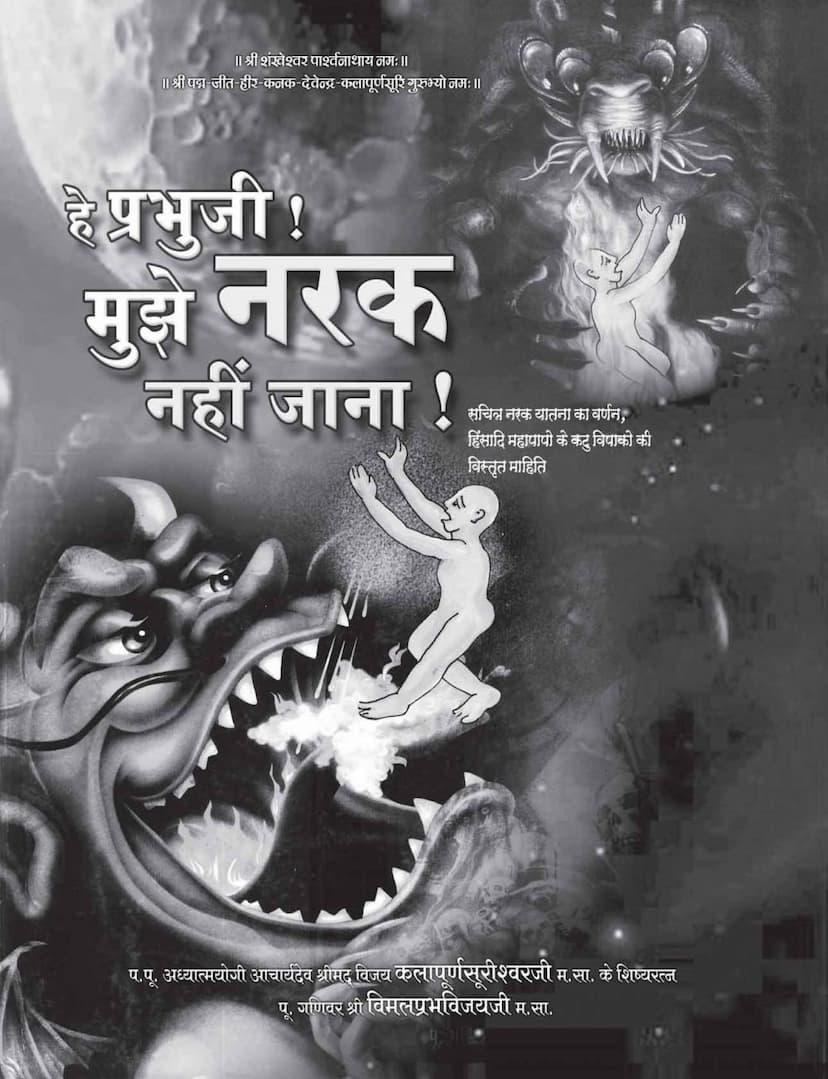Muze Narak Nahi Jana
Added to library: September 2, 2025

Summary
Here's a comprehensive summary of the Jain text "Muze Narak Nahi Jana" (I Don't Want to Go to Hell) by Vimalprabhvijay:
Book Title: Muze Narak Nahi Jana (I Don't Want to Go to Hell) Author: Vimalprabhvijay Publisher: Vimalprabhvijayji
Overall Theme:
The book is a profound and detailed exposition of the harrowing realities of hellish existence within Jain cosmology, aiming to instill a deep sense of fear and aversion towards sinful actions. The author, Vimalprabhvijay, through vivid descriptions and numerous examples, meticulously details the causes of rebirth in hell, the excruciating punishments, the nature of hellish beings, and the suffering they endure. The ultimate goal is to motivate readers to abandon sinful practices and embrace righteous conduct to avoid such a terrible fate and strive for liberation (Moksha).
Key Contents and Themes:
-
The Torment of Hell:
- The book provides graphic and terrifying descriptions of the hellish realms, emphasizing the extreme suffering experienced by the beings residing there.
- It highlights the various types of suffering, including intense heat and cold, unbearable hunger and thirst, relentless itching, burning sensations, and constant fear.
- The descriptions are so visceral that they are intended to evoke fear and a strong desire to avoid such a destiny.
-
Causes of Rebirth in Hell:
- A significant portion of the book is dedicated to outlining the specific actions and attitudes that lead to rebirth in the hellish realms. These are primarily severe sins (Mahapapas) and their associated negative consequences.
- Major Sins: The text emphasizes sins like violence (Pranatipat), falsehood (Mrushavad), theft (Adattadan), unchastity (Maithun), greed/attachment (Parigraha), anger (Krodha), pride (Man), deceit (Maya), greed (Lobha), attachment (Raga), aversion (Dvesha), quarrelsome nature (Kalaha), slander (Paishunya), false accusations (Abhyakhyan), disrespect towards elders and spiritual guides, consuming prohibited substances (like root vegetables, meat), and indulging in sensual pleasures without restraint.
- Specific Acts: Acts like abortion (garbhapat), consuming eggs (panchendriya himsa), and even certain types of business dealings that involve exploitation or harm to others are identified as causes for hellish suffering.
- Intention and Attitude: The book also stresses that the intention and underlying mindset behind actions are crucial. Cruelty, violence, and a lack of remorse contribute significantly to negative karmic accumulation.
-
The Nature of Hellish Beings (Naraki):
- The text describes the physical forms and the constant state of suffering of the hellish beings.
- They are depicted as disfigured, tormented, and perpetually in pain, unable to experience even a moment of happiness.
- Their very existence is characterized by an unending cycle of suffering.
-
The Role of "Paramadami" (Tormenting Deities):
- The book introduces the concept of "Paramadami" – malevolent celestial beings who actively inflict further suffering upon the hellish inhabitants.
- These beings are described as delighting in the torment of others, employing various cruel methods and weapons to inflict unimaginable pain.
- The detailed accounts of Paramadami's actions are intended to amplify the terror of hellish existence.
-
The Seven Hells:
- The book systematically describes the seven hells (Ratnaprabha, Sharkraprabha, Valukaprabha, Pankaprabha, Dhumprabha, Tamahprabha, Mahatamahprabha).
- It details the increasing intensity of suffering, the specific punishments, and the duration of life in each successive hell, with the lowest hell (Mahatamahprabha) being the most excruciating.
- The physical characteristics and the types of beings found in each hell are also discussed.
-
The Impact of Sins:
- The book uses numerous stories and examples of historical or mythical figures (like King Vasuraja, King Shubhuma Chakravarti, King Nand, Brahm Datt Chakravarti) who fell into hellish states due to their sins. These examples serve as cautionary tales.
- It explains how specific sins lead to specific types of punishments, creating a direct link between actions and consequences.
-
The Path to Salvation:
- While the primary focus is on the horrors of hell, the book implicitly and explicitly points towards the solution: adhering to Jain principles and practices.
- Key Virtues: The text advocates for the practice of virtues like non-violence (Ahimsa), truthfulness (Satya), non-stealing (Asteya), chastity (Brahmacharya), non-possession (Aparigraha), contentment, self-control (Samyama), penance (Tapa), devotion to the Tirthankaras, and service to the ascetics (Sadhu-Sadhvi).
- Repentance and Expiation: The importance of repentance (Pratikraman), confession (Alochna), and seeking forgiveness (Mithyami Dukkadam) for past sins is highlighted as a way to mitigate karmic consequences.
- Renunciation: Ultimately, the book points towards the path of renunciation and spiritual discipline as the surest way to escape the cycle of birth and death, including rebirth in hell.
-
Illustrative Content:
- The book likely incorporates vivid illustrations (as mentioned in reader testimonials) to visually depict the hellish suffering, making the descriptions even more impactful.
- The use of stories and examples makes the abstract concepts of karma and hell more relatable and understandable.
Overall Message and Purpose:
"Muze Narak Nahi Jana" is a powerful and essential text for Jains, serving as a stark reminder of the consequences of unrighteous living. By vividly portraying the terrifying realms of hell and the causes leading to them, the book aims to:
- Instill Aversion to Sin: To create a deep-seated fear and dislike for actions that lead to suffering.
- Promote Righteous Conduct: To inspire individuals to live a virtuous life, adhering to the principles of Jainism.
- Encourage Spiritual Discipline: To motivate followers towards penance, self-control, and devotion as means to achieve a better rebirth and ultimately, liberation.
- Serve as a Warning: To prevent individuals from making choices that would lead them to such dreadful existences.
In essence, the book acts as a spiritual wake-up call, urging readers to take their spiritual journey seriously and to prioritize actions that lead to happiness and liberation over temporary worldly pleasures that result in eternal suffering.